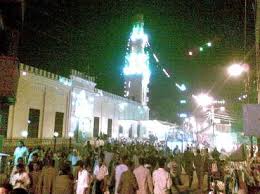The city of Qus remains a little known, but important, powerhouse in the history of Egypt, Islamic civilization, and Christian-Muslim relations. At its height within Islamic history, the city was third in Egypt only to Cairo and Alexandria—and perhaps second to Cairo in strategic importance—yet dominated by its majority Coptic community.

The location of Qus.
Today, Qus is a modest city of 60,000 in the Qena governorate, lying between the cities of Qena and Luxor. Situated on the easternmost edges of the Nile, Qus is among the closest settlements along the Nile to the Red Sea. It’s located in a large floodplain near a series of wadis that offer a natural path to the Red Sea through Wadi Zaydun and the port city of Quseir. Qus is not only located in an especially fertile area, but its prime access to both the Nile and the Red Sea places it along a central trade route. As testimony to the region’s lucky geography, Qus is just a short distance from the city of Qift, or Coptos, whence both Egypt and the Copts likely got their name.
From the time of the Fatimids up into the Mamluk period, the city served as the provincial capital of Upper Egypt, but remained dominated by its native Coptic population. Several successive Islamic empires thus relied heavily on the local Coptic population, who occupied central roles in their governments. The rise to prominence of Qus’ Coptic population can be explained through the geographical importance of the city, combined with the strong resourcefulness and trade networks of the city’s natives.
The Cathedral of Stephen the Protomartyr, the only church founded prior to Fatimid rule that still stands. The left is a photo outside the church during a fieldtrip from a girl’s high school. The right is a photo of the interior, with Coptic Pope Tawadros II speaking.

The Amri Mosque, sometimes called “al-Azhar of Upper Egypt” for its centrality in the conversion of Egypt from Shi’ism to Sunni Islam, is the oldest mosque in Qus. It is dedicated to ‘Amr b. al-‘Āṣ, the first amir under the Umayyads.
The story of Qus is one of many examples where a shared locality, a shared history, and a shared fate have tied the interests of Christians with those of their Muslim neighbors over their coreligionists, perhaps testifying to a stronger identity with their countrymen than to their Christian identity. Imperial interest in the city was at its highest when the empire was vulnerable to surrounding Christian powers. Viable threats to the region’s security and trade included not only Christian Nubia directly to the South, but also Ethiopia and the Latin Kingdom of Jerusalem.
Pharaonic-era ruins in Qus from the Temple of Horus and Heqet.
The Copts from Qus were not mere victims of imperial interests, but rather their own prosperity waxed and waned with that of the empire. They were often awarded high positions in government, perhaps reaching its peak in the period just before and after the 14th century administrative reforms of the Mamluk sultan al-Nasir Muhammad. At this time, the highest office after the sultan, the Comptroller (nāẓir al-diwān), was occupied by ethnic Copts (whose cities of origin are uncertain but were most likely from Upper Egypt, where Qus was of central importance). They had converted to Islam but remained connected to their community—they are thought to have actively and disproportionately supported the Coptic community throughout Egypt at the expense of the Muslims. Whether or not this testimony was in fact true, the suspicion alone reflects the ascendency of the Coptic community. This period witnessed a renaissance in Coptic culture, including interest in reviving the Coptic language. It was in Qus during this period that the first known Arabic grammar of the Coptic language was produced.
Yet in the same period, Qus witnessed a series of plagues, while shifting imperial interests soon after led to the decline of Qus. After threats to the region from external powers subsided, bedouin tribes internal to the region became the main threat to security and trade. The empire began to shift resources to other cities that would better shield the area from the bedouin, and Qus continued to decline up through the 17th century. By 1798, its population had dwindled to less than 5,000 before a 19th century renaissance began restoring life to the city.



